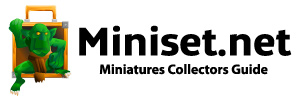AM-04: Thracian Trumpeteer
Item Code: AM-04
Description: Thracian Trumpeter (4th cent bc)
Type: Foot soldier
Scale: 65mm
Sculptor: Kostas Kariotellis
Product Contents: 5 White metal cast pieces (full body with head, right hand with trumpet, sword, shield and crest) and a metal base.
Documentation included: Historical note in English and photographic reference.
Dimensions: 100 X 155 X 35 mm
Suggested Retail Price: 31.50€
Illustrated model painted by Alexandros Chassapis and photographed in Athens Miniatures Photo Studio.
Historical Note
4th century BC
Historical evidence indicates that Thracians occupied the area of the northeastern Balkan peninsula and parts of southern Russia during the period between the 8th century BC and AD 46 when they were conquered by the expanding Romans.
Historical sources contemporary to the Thracians, (Herodotus, Xenophon and Thoucidides), reveal a tribal war-oriented nation. Thracians are described as free spirited people, of high profile in all their demonstrations of social life yet excellent and valiant fighters, skilled horsemen as well as able to exploit the battle terrain with their light infantry tactics. Their ferocious fighting abilities their love for battle and their promptness to serve as mercenaries brought the Thracians in several instances in battle against most of the ancient people. (Persians, Greeks, Celts and Romans) and gained for them enormous respect concerning their martial abilities. Roman sources referring to the Thracians after their final conquest by Rome describe them as first class fighting men. This fact indicates that this reputation was held even after their fall. After their conquest and until the 3rd century AD the Thracians retained their culture and they finally disappeared during the late 6th century AD. .
Thracians with their high level of military contact either as enemies, allies or plain mercenaries, with Greeks, Romans or the Scythian tribes to the north through out their history used a mixture of arms and armour and didn't develop a “formal” Thracian style. Furthermore, during different periods of time and geographical location influences presented a great variety.
Thracian armour was composed by a helmet of Greek influence most of the times, body armour and greaves. Helmets were lined with felt or leather. Nevertheless, one can find in sources plain felt caps, leather caps as the Kaysia or even bare headed northern Thracian warriors.
Body armour was clearly of various form and style. Initially was of Greek influence and restricted to nobles and the wearing elite until contact with the romans helped to spread body armour among lower class fighting men. Body armour was complemented by pectorals. Further protection was achieved with greaves but general use of greaves wasn't common until the 3rd century Bc.
Thracians as for their defensive armour style were also influenced in what concerns the use and selection of arms. However the Thracians became famous because of their forward curved long swords a weapon different from the Greek xiphos. These weapons where commonly in use by all ranks. In the north region Skythian influence led to the development of the Thracian akinakes a long sword that evolved in such a way as to be easy in its use by cavalry. During the late 4rth century another most powerful weapon was used by the Thracians. The romphaia. This was a heavy long two handed iron sword with the ability to sever a mans limb in one blow. Cumbersome in close quarters but very effective when conditions allowed its use was widely spread among the Thracian troops.
The figure of this edition is dressed with the typical Thracian garments, a tunic, a cloak and the typical Thracian boots, the emvades. Garments were sewn, dyed and decorated with geometrical designs especially the cloak that was the most striking article in Thracian dress. The tunic could be plain or simply decorated at the hem. The emvades were another distinctive feature. Covered entirely the feet and part of the lower leg, made of fawn skin and were laced in front. A number of flaps were hanging down from the top.
The figure is protected by a composite corselet with scales in the front part and an early type Chalkidian helmet without hinges. A pectoral added extra protection and would have also served as a sign of rank. In the left hand the figure holds a trumpet and is armed with a long straight sword a small dagger and slung on his back a pelti, the typical Thracian crescent shaped light shield .






